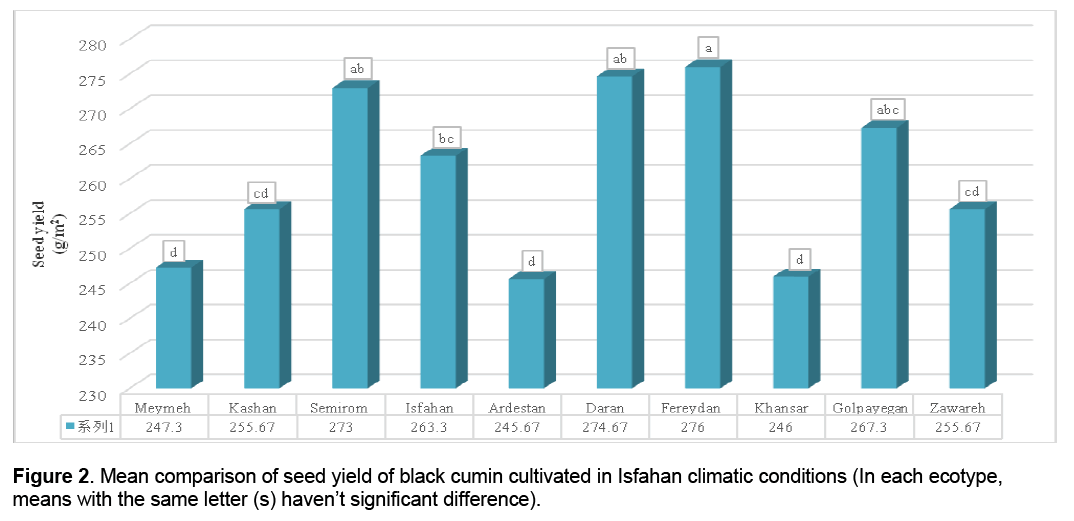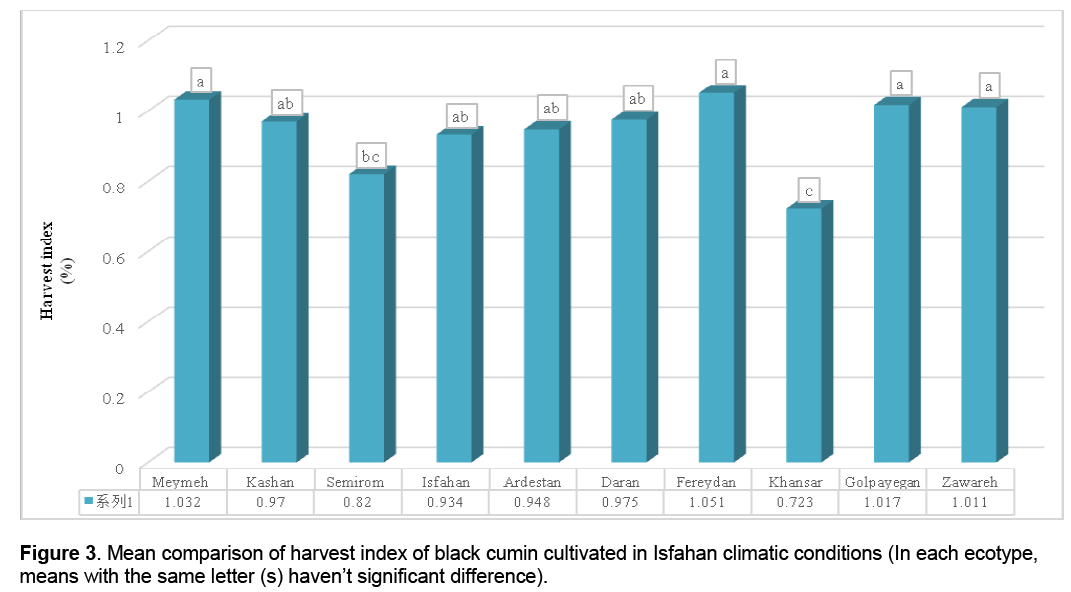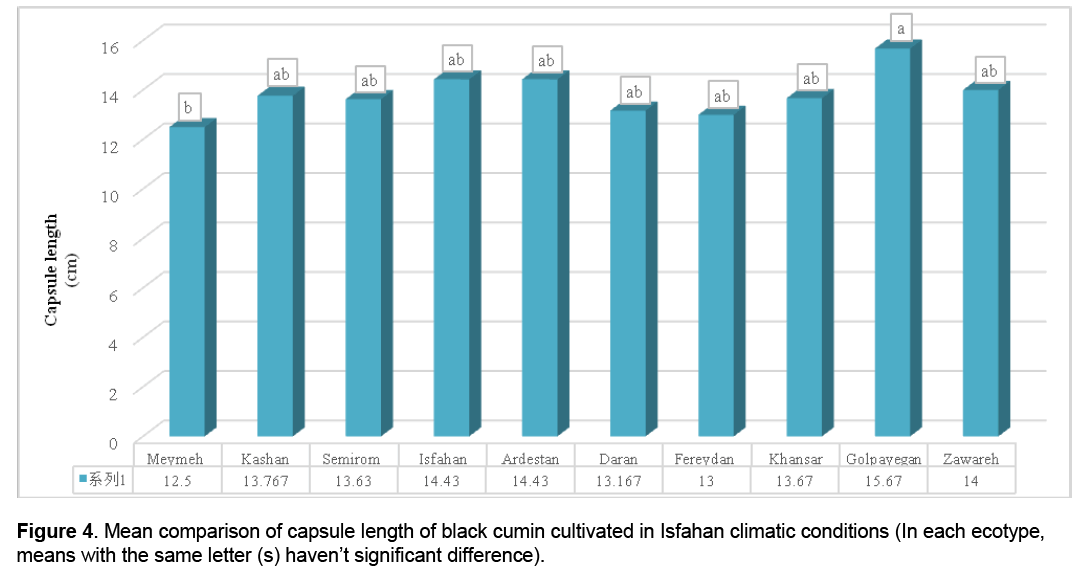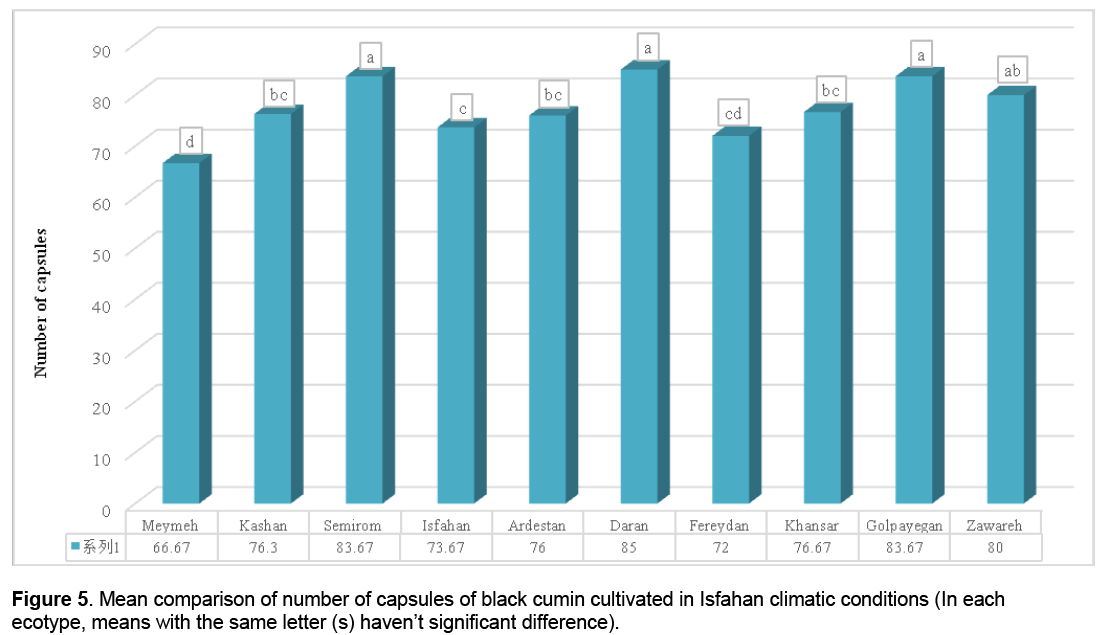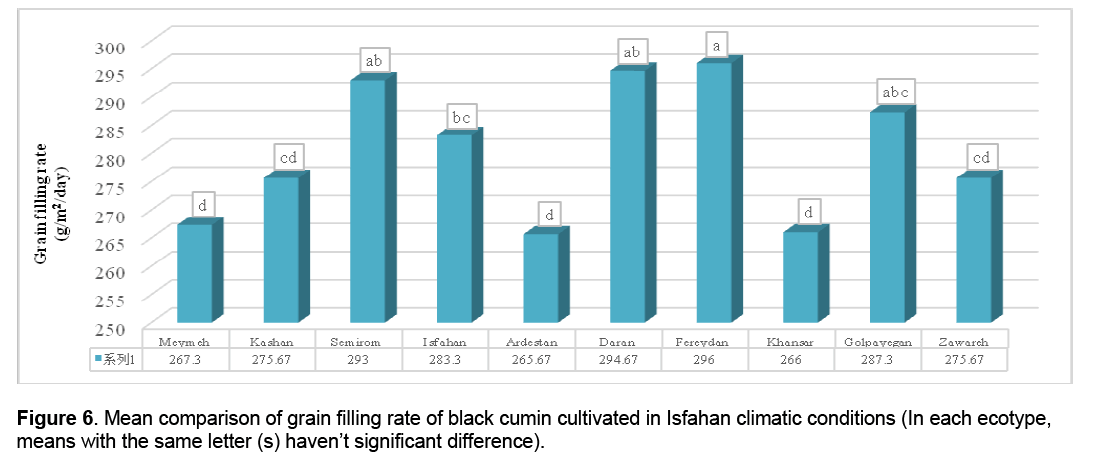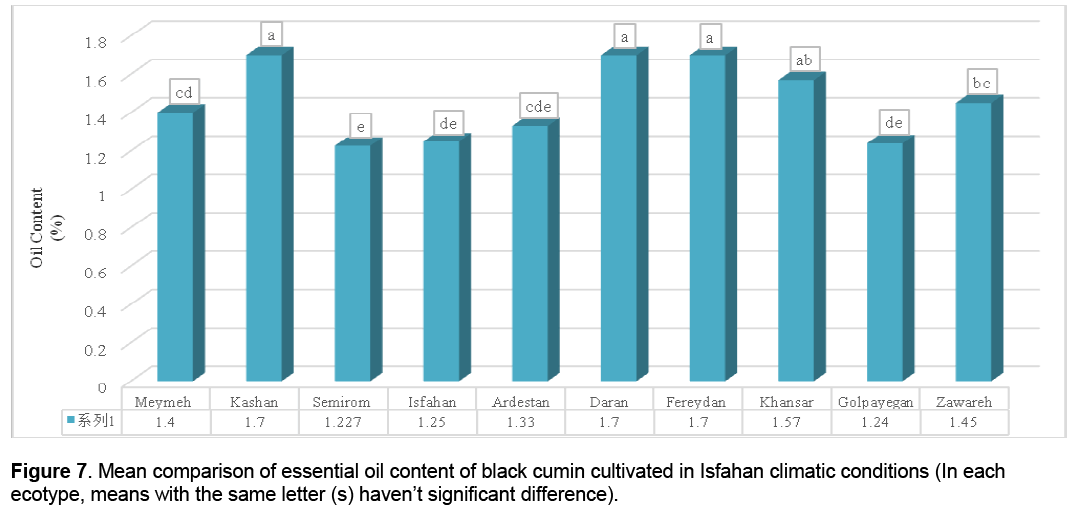Investigation of Seed Yield and Oil Quality of Black Cumin (Nigella sativa L.) Ecotypes Cultivated in Isfahan Province
Ahmad Reza Golparvar, Amin Hadipanah, Saied Salehi
Ahmad Reza Golparvar1,*, Amin Hadipanah2, Saied Salehi3
1Department of Agronomy and plant Breeding, College of Agriculture, Isfahan (Khorasgan) Branch, Islamic Azad University, Isfahan, Iran;
2Department of Horticultural - medicinal plants Science, College of Agriculture, Tehran Science and Research Branch, Islamic Azad University, Tehran, Iran;
3Department of Agronomy, College of Agriculture,Tehran Science and Research Branch, Islamic Azad University, Tehran, Iran.
- Corresponding Author:
- Tel: +983115354001
Fax: +983115354060
E-mail: dragolparvar@gmail.com
Abstract
Black cumin (Nigella sativa L.) is an annual plant belongs the family Ranunculaceae, it grows to 20–40 cm tall and about eight species in Iran, also known as the black cumin seeds or small fennel have tremendous potential for cultivation and is native in Europe, Middle East and Western Asia. This experiment has been conducted in research field of Islamic Azad University, Isfahan (Khorasgan) branch, in center Iran, during spring 2013. Experiment was planned based on a randomized complete block design with three replications. Seed of ten ecotypes viz; Semirom, Zawareh, Golpayegan, Fereydan, Meymeh, Kashan, Khansar, Daran, Ardestan and Isfahan were sown. All measured characters (number of branches, seed yield (g/m2), harvest index (%), capsule length (cm), number of capsules, seed fill speed (g/m2), essential oil content (%) and essential oil yield (g/m2)) were subjected to the analysis of variance. Analysis of variance revealed significant difference among different black cumin ecotypes for number of branches, seed yield, harvest index, number of capsules, grain filling rate, essential oil percentage and essential oil yield. Mean comparison showed that the highest of seed yield (276 g/m2) obtained in Fereydan ecotype while the highest of essential oil percentage (1.7%) was extracted in Fereydan, Kashan and Daran ecotypes. Furthermore, the highest amount of essential oil yield (4.694 g/m2) was observed in Fereydan ecotype. In conclusion, Fereydan and Daran ecotypes showed the optimum amount of essential oil content and seed yield in black cumin ecotypes cultivated in Isfahan climatic conditions.
Keywords
Nigella sativa L., morphological traits, seed yield, essential oil content.
Introduction
Black cumin (Nigella sativa L.) is a medicinal plant belongs the family Ranunculaceae. The body of this annual plants is 20-40 cm height, straight, and lightly feathered, with finely divided, linear (but not thread-like) leaves. The flowers are delicate, and usually coloured pale blue and white, with five to ten petals (2 – 2.5 cm). Seeds flattened, oblong, small (0.2 cm long, 0.1 cm wide and 1mm thick), black in colour and inflated capsule composed of three to seven united follicles, each containing numerous seed and about eight species in Iran [1,2]. Black cumin is native in Europe, Middle East and Western Asia [3]. It also grows in most parts of Iran such as Arak, Kermanshah, Isfahan and other parts of the country. Black cumin originally grown in arid and semi-arid regions [4,5].
The seeds of Nigella sativa contain thymoquinone, monoterpens such as p-cymene and pinene, nigellidine, nigellimine and saponin [6]. The seeds have also been found to contain fats, crude fiber, minerals; e.g. Fe, Na, Cu, Zn, P, Ca and vitamins like ascorbic acid, thiamine, niacin, pyridoxine and folic acid [7]. Nickavar et al [8] reported the chemical composition of the extracted fixed oil and volatile oil of Nigella sativa L. seeds grown in Iran were eight fatty acids (99.5%) and thirty- two compounds (86.7%) have been identified in the fixed and volatile oils, respectively. The main fatty acids of the fixed oil were linoleic acid (55.6%), oleic acid (23.4%), and palmitic acid (12.5%). The major compounds of the volatile oil were trans-anethole (38.3%), p-cymene (14.8%), limonene (4.3%), and carvone (4.0%). The seeds have the anthelmintic, insecticidal, antimalarial, antibacterial, antifungal and antitumor activates. The seeds are also reported to have antispasmodia, diuretic, carminative, digestive and antiseptic properties [9]. Salamati and Zeinali [10] reported that investigate genetic diversity and relationships among morphological traits in 21 genotypes of (Nigella sativa L.) in Iran, seed yield varied from 63.34 g in genotype of Shiraz to (147.36 g) in genotype of Zabol. Therefore, the aim of this study was to investigation of seed yield and oil quality 10 ecotypes of black cumin (Nigella sativa L.) in Isfahan province.
2. Materials and Methods
Plant materials
This experiment was conducted in research field of Islamic Azad University, Isfahan (Khorasgan) branch in center Iran (32ÃÆâÃâââ¬âÃâæ, 38_ N and 51ÃÆâÃâââ¬âÃâæ, 47_ E, 1550 m above sea level), during spring 2013. The experiment was planned based on a randomized complete block design with three replications. This location is arid and warm area (according to the Koppen climate classification) characterized by warm and dry summers. The long-term (30 years) mean annual rainfall and temperature of area was 121.1 mm and 33.4 centigrade degrees, respectively. The soil texture of the experimental field was clay loam type with pH 7.37, contains total N (0.75 %), total P2O5 (35 ppm) and total K2O (452 ppm) with an EC of 4.69(ds/m). Weeds were removed by hand weeding during growth stages. Seed of ten black cumin ecotypes namely; Semirom, Zawareh, Golpayegan, Fereydan, Meymeh, Kashan, Khansar, Daran, Ardestan and Isfahan were cultivated in 0.3 m apart between rows and 0.3 m inter-row spacing. Measurement was done for the traits such as; number of branches, seed yield (g/m2), harvest index (%), capsule length (cm), number of capsules, grain filling rate (g/m2/day), essential oil percentage (%) and essential oil yield (g/m2).
Essential oil extraction
The isolation of the essential oil from the 100 g of powdered seeds was done by hydrodistillation for 4 h using a modified Clevenger-type apparatus, according to producers outlined British Pharmacopoeia.
Statistical analysis
All the data were subjected to analysis of variance based on statistical model of randomized complete block design. Then existence of significant difference among the means of black cumin ecotypes were evaluated by Duncan's new multiple range test (DNMRT) at 5% probability level. SPSS16 software was used to statistical analysis.
3. Results
Analysis of variance (Table 1) showed the significant effect of different black cumin ecotypes on number of branches, seed yield, harvest index, number of capsules, grain filling rate, essential oil percentage and essential oil yield.

3.1 Number of branches
The highest of number of branches (192.6) was obtained in Fereydan ecotype and the lowest (164) in Ardestan ecotype (Figure 1).
3.2 Seed yield
The highest seed yield (276 g/m2) was obtained in Fereydan ecotype while the lowest (245.6 g/m2) in Ardestan ecotype (Figure 2).
3.3 Harvest index
Maximum harvest index (1.05%) was observed in Fereydan ecotype and the lowest (0.724%) in Khansar ecotype (Figure 3).
3.4 Capsule length
The highest capsule length (15.6 cm) was obtained in Golpayegan ecotype while the lowest (12.5 cm) in Meymeh ecotype (Figure 4).
3.5 Number of capsules
Maximum number of capsules (85) was observed in Daran ecotype and the lowest (66.6) in Meymeh province ecotype (Figure 5).
3.6 Grain filling rate
Maximum grain filling rate (296 g/m2/day) was observed in Fereydan ecotype while the lowest grain filling rate (265.6 g/m2/day) was obtained in Ardestan ecotype (Figure 6).
3.7 Essential oil content
The results obtained in our study showed that the highest amount of essential oil content (1.7%) was extracted in Fereydan, Kashan and Daran ecotypes. On the other hand, the lowest essential oil content (1.22%) was extraxted in Semirom ecotype (Figure 7).
3.8 Essential oil yield
The highest essential oil yield (4.694 g/m2) was obtained in Fereydan ecotype while the lowest essential oil yield (3.29 g/m2) was observed in Isfahan ecotype (Figure 8).
4. Discussions and Conclusions
In the present research, the highest number of branches, seed yield, harvest index, grain filling rate, essential oil content and essential oil yield were obtained in Fereydan ecotype (Figures 1, 2, 3, 6, 7 and 8). The reason might be the better remobilization that occurs in black cumin ecotypes and causes the seeds to be filled better. Although, for considering the traits such as the seed yield as selection criteria more care must be taken. Because, if the plant is too dwarf, it might lead to reduce the competition of plant to get light and other environmental parameters, thus the seed yield would diminish. Therefore, it is necessary that the best morphological traits are studied more carefully [11]. Faravani et al [12] reported significant differences for plant height, 1000-seed weight, seed yield, number of stem branches, weight of capsule and xylem and phloem diameter on the 28 landraces of Nigella sativa were collected from Khorasan province in Iran.
Black cumin seeds are important in herbal medicines commonly employed in Iran. The environmental factors like climate and location might be a possible reason for these variations. Moreover, difference in genetic makeup could also be a contributing factor as indigenous variety was tested in the trial. Nigella sativa L., is a new crop in the country and the first step for successful introduction is evaluation of diverse germplasm that not only helps to identify the superior genotypes, but selected genotypes could also be used in agronomic experiments [13]. The 1000-seed weight is an important yield contributing traits in most of the crops as reported by [14] and [15], but negative association of 1000-seed weight with yield and its components is suggested to break through mutation, selective diallel or back cross method.
The study of correlation between seed yield and other important agronomic traits is very important to choose the desirable cultivars. The analysis of indices allows the direct effects of each trait on seed yield to be separated from indirect effects existing in mutual relations of different traits [16]. Fanaei et al [17] reported that black cumin could be planted of Sistan region in spring and autumn, but have highest product on autumn season. Black cumin with 933 kg/ha seed yield could have roles both in planting pattern and the farmers income increase.
On the other hand, days to full flowering and head diameter have a negative correlation as well as direct and negative effect on seed yield. Thus, selection for the lowest amounts of this trait can increase the seed yield. In other words, it is possible that the choice of genotype that enter the generative stage sooner and also terminate the flowering stage faster, causes the plant to escape preventing it from encountering the heat of end of the season. This mechanism leads to enhancement of the yield in stress conditions of the end of season [18].
Talebi Kouyokhi et al [19] reported that phytochemical variations were not only found among samples of different regions but also among samples of the same region with different altitude reflecting the effect of environment on essential oil components. It has been reported that yield and its components in plants in general is primarily related to their genetic [20], climate, edaphic, elevation and topography as well as their interaction. Recent findings indicated that some of the medicinal plant characteristics can be affected by genetic and ecological factors, including precipitation, temperature and plant competition. Since essential oils are the product of a predominantly biological process further studies are needed to evaluate if the reported characteristics of each population are maintained at the level of individual plants and along the breeding and selection program when grown under climatic conditions [21]. According to the results of the present study, Fereydan and Daran ecotypes produced the highest amount of seed yield and the best quality of essential oil of black cumin (Nigella sativa L.) cultivated in Isfahan climatic conditions.
Acknowledgements
This research project has been supported by Islamic Azad University, Isfahan (Khorasgan) branch, Isfahan, Iran. This support is highly appreciated.
References
- Ghahreman, A. (1993). Plant systematics coromphtes of Iran, 2: 29-38.
- Mozaffarian, V. (1998). A Dictionary of Iranian Plants Names. Farhang Moaser Publishers, Tehran, pp. 365.
- Iqbal, M.S., Qureshi, A.S., Ghafoor, A. (2010). Evaluation of Nigella sativa L., for genetic variation and Ex-situ conservation. Pakistan Journal of Botany, 42(4): 2489-2495.
- Moody, H., Rashid Mohasel, M. (1998). Effect of plant density and nitrogen on yield and yield components of (Nigella sativa), Crop Science Congress Abstracts.
- D’Antuno, L.F., Moretti, F., Lovato, F.S. (2002). Seed yield, yield components, oil content and essential oil content and composition of Nigella sativa L. and Nigella damascene L. Industrial Crops Products, 59–69.
- Ansari, A.K., Sadiy, H.A.S. (1989). Structural studies on a saponin isolated from the seeds of Nigella sativa. Journal Phytochemistry, 27: 377-9.
- Takruri, H.R.H., Dameh, M.A.F. (1998). Study of the nutritional value of black cumin seeds (Nigella sativa). Journal Sciences Food Agriculture, 76: 404-410.
- Nickavar, B., Mojab, F., Javidnia, K., Roodgar Amoli, M.A. 2003. Chemical composition of the fixed and volatile oils of Nigella sativa L. from Iran. Verlag der Zeitschrift fur Naturforschung, 58: 629-631.
- Ali, A., Alkhawajah, A.A., Randhawa, M.A., Shaikh, N.A. (2008). Oral and interaperitoneal LD50 of thymoquinone an active principal of Nigella sativa in mice and rats. Journal Ayub medicinal Coll, 20(2): 25-7.
- Salamati, M.S., Zeinali, H. (2013). Evaluation of genetic diversity of some (Nigella sativa L.) genotypes using agro-morphological characteristics. Iranian Journal of Medicinal and Aromatic Plants, 29(1): 201-214.
- Golparvar, A.R., Hejazi Dehaghani, M.R. (2012). Determination of the best indirect selection criteria for genetic improvement of seed yield in sunflower(Helianthus annus L.) genotypes. Agriculturae conspectus Scientificus, 77 (2): 87-90.
- Faravani, M., Razavi, A.R., Farsi, M. (2006). Study of variation in some agronomic and anatomic characters of Nigella sativa L. landraces in Khorasan. Iranian Journal of Medicinal and Aromatic Plants, 22(3): 193-197.
- Shadia, K.A., Malaka, E.I., Aly, A.F. (1998). Effect of sowing dates and planting distances on Nigella sativa. Egyptian Journal Agriculture Research, 76(3): 1145-1156.
- Ghafoor, A., Arshad, M. (2008). Multivariate analyses for quantitative traits to determine genetic diversity of blackgram (Vigna mungo L.) Hepper germplasm. Pakistan Journal of Botany, 40(6): 2307-2313.
- Iqbal, M.S., Qureshi, A.S. Ghafoor, A., Qayyum, A. (2003). Identification of superior genotypes based on morphological, physiological and agronomic traits in local and exotic cowpea germplasm. Pakistan Journal of Botany, 35(1): 69-77.
- Mokhtassi Bidgoli A., Akbari G.A., Mirhadi M.J., Soufi zadeh S. (2006). Path analysis of the relationships between seed yield and some morphological and phenological traits in safflower (Carthamus tinctorius L.). Euphytica, 148: 261-268.
- Fanaei, H.R., Akbari Moghadam, H., Keykha G.H.A., Ghafari, M., Aali, A.A. (2006). Evaluation of agronomy and essential oil components of (Cuminum cyminum L.), (Foeniculum vulgar L.) and (Nigella sativa L.) in the condition of Sistan region. Iranian Journal of Medicinal and Aromatic Plants, 22(1): 34-41.
- Richards R.A. (1996). Defining selection criteria to improve yield under drought. Plant Growth Reg, 20: 157-166.
- Talebi Kouyokhi, E., Naghavi, M.R., Alayhs, M. (2008). Study of the essential oil variation of Ferula gummosa samples from Iran. Chemistry of Natural Compounds, 44(1): 124-126.
- Safaei Ghomi, J., Meshkatalsadat, M.H., et al (2009). Chemical characterization of bioactive volatile molecules of four Thymus species using nanoscale injection method. Digest Journal of Nanomaterials and Biostructures, 4(4): 835-841.
- Ghasemi Pirbalouti, A. and Mohammadi, M. (2013). Phytochemical composition of the essential oil of different populations of Stachys lavandulifolia Vahl. Asian Pacific Journal of Tropical Biomedicine, 3: 123–128.

Open Access Journals
- Aquaculture & Veterinary Science
- Chemistry & Chemical Sciences
- Clinical Sciences
- Engineering
- General Science
- Genetics & Molecular Biology
- Health Care & Nursing
- Immunology & Microbiology
- Materials Science
- Mathematics & Physics
- Medical Sciences
- Neurology & Psychiatry
- Oncology & Cancer Science
- Pharmaceutical Sciences

